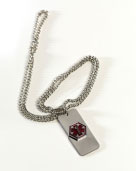Low Blood Glucose (Hypoglycemia)
Hypoglycemia (said like: hi poe glie SEE mee ah), or low blood glucose, is the most common problem with insulin therapy. Low blood glucose is when the blood glucose falls below 70 mg/dl. Hypoglycemia can happen very quickly.
What Causes Low Blood Glucose?
- Not enough carbohydrates eaten
- Too much insulin given
- More exercise than normal
How do I Prevent Low Blood Glucose?
- The best way to prevent low blood glucose is to take insulin based on the amount of carbohydrates you are eating, your blood glucose level, and your planned activity level.
- Plan ahead if you know you will be doing more activity than normal.
- Test your blood glucose regularly.
What do I Need to be Ready for a Low Blood Glucose?

- Know YOUR signs of low blood glucose. Your family and friends will also need to learn your signs of low blood glucose so they can help you treat it.
- Always keep some form of sugar with you.
- Always keep your blood glucose meter with you.
- Always have a Glucagon Emergency Kit (see page 49).
- Always wear a medical necklace or bracelet, or carry a medical ID card in your wallet.
What are the Signs of Low Blood Glucose?
Because sugar (glucose) is the main fuel for the brain, a sudden drop in the glucose level can cause the following symptoms:
| Early Signs | Late Signs | Signs While Sleeping |
| shakiness | Personality Change | Nightmares |
| Nervousness | Seizures | Waking up suddenly |
| Stomach ache | Confusion | Sweating; wet clothes or sheets |
| Weakness | Irritability, crankiness | Fast heartbeat |
| Blurry vision | Unconsciousness | Can't fall back to sleep; restless |
| Dizziness | ||
| Pale skin | ||
| Sweating | ||
| Headaches |
How do I Treat Low Blood Glucose with the 15/15 Rule?
Step 1: Stop what you are doing if you have any signs of low blood glucose, and check your blood glucose. You may have to:
- Let your coach know you need a break.
- Leave class in the middle of a lesson and go to the nurse’s office.
Step 2: Read the results.
-
For children up to 1 year old, tre
at blood glucose of 90 or below. - For children 1 to 4 years old, treat a blood glucose of 80 or below.
- For children 5 years old or more, treat a blood glucose of 70 or below.
Step 3: Treat the low blood glucose with a 15 gram carbohydrate snack that works fast (Picture 1). This is called a fast-acting carbohydrate. If your blood glucose is low, your body needs sugar quickly. If these symptoms are not treated, seizures and/or unconsciousness can happen.
Eat a 15 gram fast-acting carbohydrate. One of the following would be a good choice:
- 4 ounces of 100% fruit juice
- 3 to 4 glucose tablets
- 1 tube of glucose gel
- Candy, like Skittles or gummy bears.
|
Do not use candy bars or other candy that has fat. |

Picture 1: Always carry some kind of glucose with you, like glucose tablets or fruit juice.
Step 4: Check your blood glucose again in 15 minutes. Do this even if you feel better.
-
If your blood glucose is still below target range (70 - 80 mg/dl), repeat steps 3 and 4.
-
If your blood glucose is above target range (70-80 mg/dl) and it is more than 1 hour until your next meal, eat another 15 gram carbohydrate snack with protein. This can be any of the following:
-
Peanut butter or cheese and crackers
-
Half of a sandwich
-
Granola bar
-
One glass of milk
-
What do I do about Low Blood Glucose at Nighttime?
It is a good idea to keep small boxes or cans of juice at your bedside to treat low blood glucose in the middle of the night. Make sure to follow up with a snack of 15 grams of complex carbohydrate and protein before going back to bed. Cheese and crackers are a good choice. You do not need to eat a full meal.
| Important to Remember |
| Remember, if blood glucose is below target before a meal, treat before you eat. When blood glucose is above 70 mg/dl, take your insulin before you eat a meal or another snack. |
| If you have signs of low blood glucose, but cannot test your blood, you should treat for low blood glucose anyway. Use the 15/15 Rule, giving yourself 15 grams of carbohydrate and checking your blood glucose in 15 minutes. |
| Have a signal for your teacher or your coach that lets them know you are having signs of low blood glucose. |
Back to the Managing Your Diabetes Resource Book Table of Contents »
